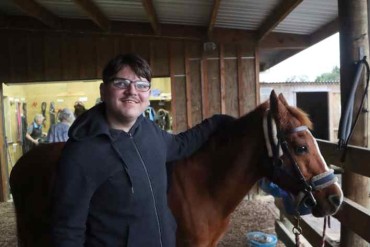Nathan's story

Nathan is 15 (going on 16) and enjoys photography and 3D modelling on his computer. He is an enthusiastic learner and his favourite subjects at school are Maths, Digital Technologies, and DVC (Design and Visual Communication). However, for Nathan’s first two years of High School, education was made inaccessible to him.
Nathan has Autism and has a rare chromosome deletion. There are less than 20 people in the world known to have this condition. Nathan experiences a multitude of symptoms including chronic pain and fatigue, Raynaud's syndrome, and developmental co-ordination disorder. As a result, Nathan experiences significant mobility issues which make walking, standing, and even sitting for long periods of time very tiring for him. He also is prone to tripping and falling often due to his co-ordination difficulties.
For his first year of high school Nathan struggled with attending class. He found walking around the large school campus to be exhausting, and some of his subjects were up a steep set of stairs. Kathleen, Nathan’s mother, asked the school if they could provide Nathan with access to the building’s elevator. The school refused. The school cited Nathan’s lack of funding as their reason for this decision.
Kathleen also asked if Nathan could start using his mobility scooter at school on his bad days to increase his attendance. The school started making multiple excuses about how this wasn’t possible while making zero effort to make accommodations for Nathan’s needs. One of these excuses was that the pathways were not in suitable condition. This was despite students having used electric wheelchairs on campus within recent history, proving that the use of electric mobility devices at school wasn’t impossible; despite the school’s claims.
The high school’s refusal to allow Nathan to use the elevator or his mobility scooter severely impacted Nathan’s attendance.
At the beginning of the next school year, Nathan had a serious fall. He tripped on concrete, severely scraping his face and suffering from a concussion. The school nurses wrapped bandages around Nathan’s face and head before calling Kathleen to take him to hospital.
This fall was a major setback regarding Nathan’s mobility. Once again, Kathleen asked the school if Nathan could use the elevator and his mobility scooter. This time, the school agreed that Nathan could use the mobility scooter. However, they told Kathleen that Nathan would have to leave the scooter outside his classes or at the bottom of the stairway when going to class upstairs. This meant that the scooter would be in a position to easily get stolen. Nathan decided that he didn’t want to risk this.
For the first term following his fall, Nathan was enrolled in Te Kura correspondence, which allowed him to complete work from home. This worked well for Nathan and he submitted the required work. However, Nathan’s high school decided to attempt to transition him back to in-person attendance.
Nathan’s disability along with his post-concussive symptoms meant that Nathan once again struggled to attend school. On average, Nathan was only able to attend a total of a few hours a week due to his health. Kathleen asked if the school could provide Nathan with online work to complete from home. The school did not cooperate with this request, leaving Nathan with no way to complete schoolwork.
When Kathleen went to the Ministry of Education in the hopes they’d help her find a solution to make education accessible to Nathan, the Ministry instead suggested that Nathan should leave high school all together. They told Kathleen that they would sign an Early Leaving Certificate for Nathan if he enrolled in a course such as a Primary Industry Skills course.
However, due to Nathan’s level of physical ability Kathleen knew this wouldn’t be possible. This response from the Ministry made Kathleen feel like they were trying to kick Nathan out of the school system rather than provide him with access to an education.
While trying to figure out a solution before Nathan entered NCEA the next year, Nathan’s mother was told by a learning support teacher at his high school that Nathan would not be capable of ever gaining any NCEA credits.
After a year of fighting, Kathleen finally managed to get Nathan enrolled full-time in TeKura (a correspondence school) which has completely turned things around for Nathan. Being able to complete schoolwork from home, with a relatively flexible schedule, has finally given Nathan the tools he needs to access his education. Nathan is now on track to achieve his NCEA Level One, with more than half of his credits so far being of Merit or Excellence level.
Besides Nathan finally having access to an education, schooling from home has also given Nathan more energy to engage in social activities such as Riding for the Disabled and StarJam.
Looking back at his experiences, Nathan wishes he had done correspondence school through TeKura from the beginning of his high school education.
Once he graduates high school, Nathan hopes to enrol in a tertiary digital design course.
Written by Amy Clements